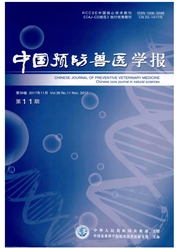

 中文摘要:
中文摘要:
为对猪链球菌(SS)病的防控提供参考依据,本研究对广东地区养殖场健康猪群采集的455份样品,屠宰场采集的243份样品和疑似SS发病猪群采集的228份样品进行了SS携带情况统计分析。结果显示,健康猪群、屠宰场屠宰猪群及发病猪群SS的阳性率分别为42.20%(192/455)、32.10%(78/243)及82.02%(187/228)。血清型定型结果显示,健康猪群共检测到17个血清型,主要以2型和29型为主,分别占18.83%(29/154)和14.94%(23/154),其次为16型,占6.50%(10/154),未定型菌株占31.82%;发病猪群共检测到11个血清型,主要以2型(16.58%)、3型(9.63%)和7型(6.95%)为主,其次为9型(5.34%),未定型菌株占48.66%。对比发现健康猪群和发病猪群携带SS的血清型有所差异,可为临床SS病的预防防控提供参考依据。
 英文摘要:
英文摘要:
To investigate the epidemic of Streptococcus suis(SS) in Guangdong province,and providing reference for the prevention and control of SS,we have made detailed statistical analysis of the carrying situation of SS,including 228 samples from infected swine,243 samples from tonsils of slaughtered pigs and 455 nasal swabs of healthy swine in Guangdong area.The results showed that the positive rates of SS of hedthy,slaughtered and infected swine were 42.20%(192/455),32.10%(78/243) and82.02%(187/228),respectively.17 serotypes were detected from the healthy swine(including farms and slaughterhouse),and the main types were SS2(18.83%),SS29(14.94%) and SS16(6.50%).Besides,11 serotypes were confirmed from the infected swine,which were SS2(16.58%),SS3(9.63%),SS7(6.95%),and SS9(5.34%).The rates of non-typable strains were 31.82%and48.66%in the healthy and infected swine.The result of comparative analysis indicated that the serotypes of SS had some differences in the healthy and infected swine,which provided reference for the control and prevention of SS.
 同期刊论文项目
同期刊论文项目
 同项目期刊论文
同项目期刊论文
 期刊信息
期刊信息
